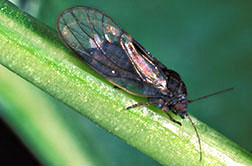Killing Psylla in Cold Blood
 To determine the effectiveness of the Pseudomonas syringae bacterium as a biocontrol, entomologist David Horton samples the population density of pear psylla in a Bartlett pear tree. (K7349-8) |
Scientists are exploring the possible use of the Pseudomonas syringaebacterium, freeze-dried, to control insects pests on pears.
Operators of ski resorts may have more first-hand knowledge about these critters than most entomologists. They use the commercially available bacteria to make artificial snow for their ski slopes. It’s done by dissolving the bacteria in water and spraying the solution over ski runs, prompting the formation of tiny ice grains that closely match the consistency of real snow.
Richard Lee, Jr., an internationally known expert on insect cold hardiness at Miami University in Oxford, Ohio, has used the bacteria to kill Colorado potato beetles and insect pests in grain silos. Scientists now hope the bacteria can also be used against pear psylla, a major pest of pears nationwide and the most severe insect pest of pears in the Pacific Northwest.
David R. Horton and Lisa G. Neven, Agricultural Research Service entomologists, have learned when pear psylla are least cold hardy and thus probably the most susceptible to the bacteria's effects. Their studies show that cold hardiness parallels winter temperatures. The psylla are most cold hardy in December and less so both earlier and later than December.
Entomologists know that interior ice formation is deadly for many insects. To survive winter, these insects must remain unfrozen, even at subzero temperatures—a process termed supercooling.
Several organisms, including some bacteria, cause the supercooled liquids inside insects and on their body surfaces to freeze spontaneously. As at ski resorts, the microorganisms act as catalysts. Ice forms around the little particle-like bacteria and proves fatal to insects.
"This is like the classical high school science experiment," explains Horton. "A small amount of pure, distilled water can be cooled, without freezing, to a lower temperature than a similar volume of tap water. Microparticles in the tap water serve as nuclei around which ice can form, speeding ice formation." Horton is at the ARS Yakima Agricultural Research Laboratory in Wapato, Washington.
"Overwintering psylla spontaneously freeze when temperatures drop to 9 below zero Fahrenheit. Dr. Lee has shown that spraying psylla with freeze-dried bacteria causes freezing to occur at 10 above," says Horton. "My own studies show that mortality in psylla actually begins at temperatures well above the point at which the insects spontaneously freeze. Many actually die at temperatures above zero.
"The bacteria could make insects in the Northwest more susceptible to low winter temperatures."
 Pear psylla, a major pest of pears nationwide (about 15x actual size). (K7347-1) |
They might get a double punch by combining the freeze-dried bacteria with solutions of soap and water. In tests in the ARS lab, Horton and Neven noted that over 24 hours, pear psylla misted with soapy water died at temperatures near 20°F. Many nonmisted insects were able to survive temperatures as low as zero.
"We assume the surfactant, or soapy water, increased the "wettability" of the insects sufficiently that the water was able to enter otherwise moisture-free openings in the insects. As the water froze, ice presumably had an easy and direct route to the interior of the insects, resulting in death,” says Horton. “By combining surfactants and the bacteria, we may be able to get more of the bacteria into openings in the insect.”
Horton says the tricky part will be to get the spray onto insects at the right time. Scientists know that during a normal season about half of the pear psylla leave orchards in late fall and take up residence in other trees. They hide in tiny cracks and crevices in the bark. Ideally, application would be before this exodus.
Horton and Neven will continue studies with Lee, and they will also collaborate in field studies with Everett Burts and John Dunley from Washington State University at Wenatchee. This research is partially funded by growers through the Washington Tree Fruit Research Commission. — By Dennis Senft, ARS.
David R. Horton and Lisa G. Neven are at the USDA-ARS Yakima Agricultural Research Laboratory, 5230 Konnowac Pass Road, Wapato, WA 98951; phone (509) 454-6556
"Killing Psylla in Cold Blood" was published in the December 1996 issue of Agricultural Research magazine.






